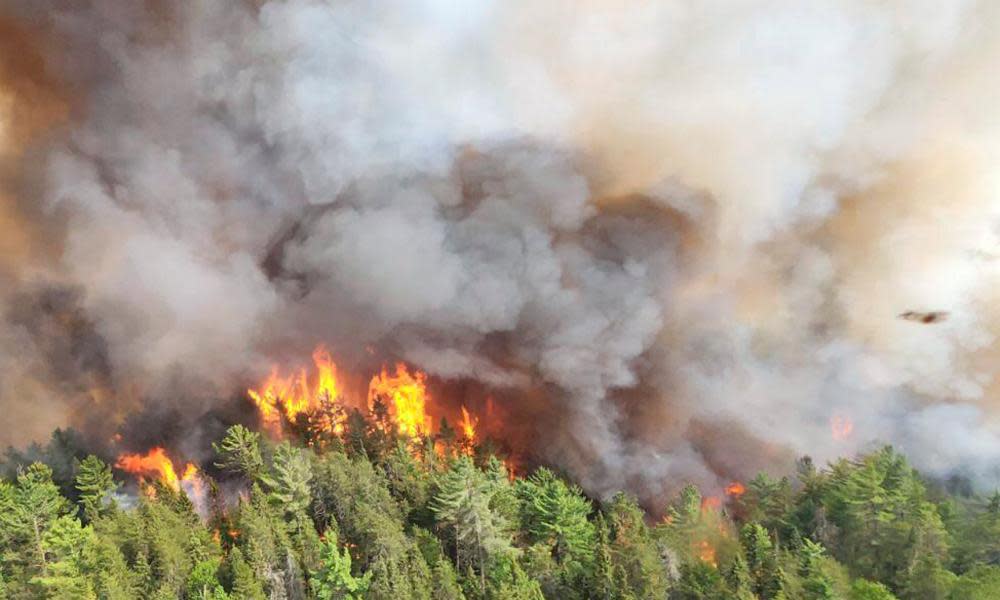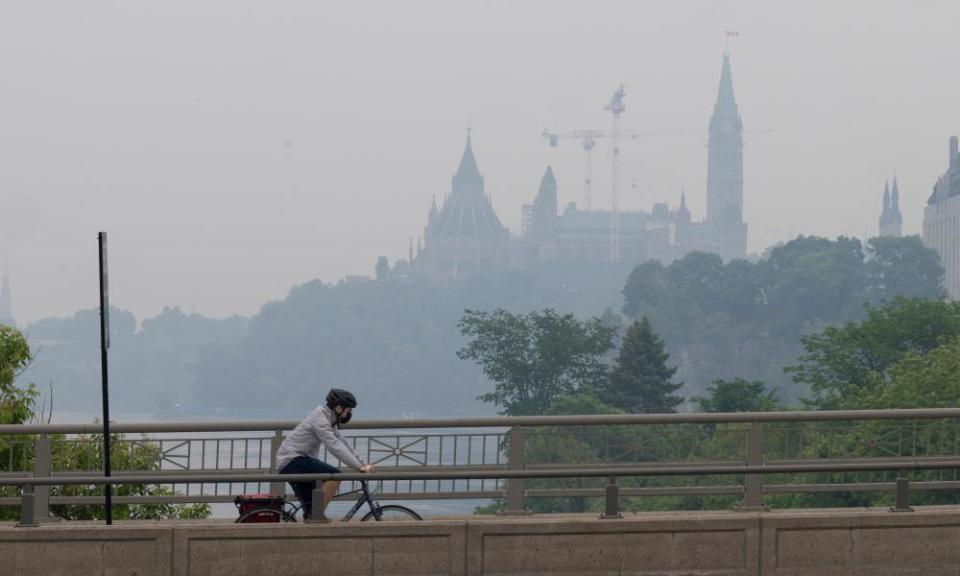Exhausted crews battle Canadian wildfires as experts issue climate warning

Weeks of unprecedented wildfires in Canada have burned millions of hectares, displaced more than 100,000 residents and plunged the country into a nationwide crisis as exhausted crews battle hundreds of blazes. But experts caution that a changing climate and human actions on the landscape will probably make fire seasons worse in the coming years.
Hundreds of firefighters from across the world have flown to Canada to aid a nation stretched thin with a spring fire season that has shattered records on both sides of the country, with warmer and drier months still to come.
As of Friday, there were 421 fires burning, down from 441 on Wednesday, according to the Canadian Interagency Forest Fire Centre. The number of fires deemed out of control also dropped from 256 on Wednesday to 230, aided by rains that hit areas of Quebec. More than 43,000 sq km have burned so far this year, making 2023 the second worst year for fires on record – a milestone from 2014 probably eclipsed this weekend.
Earlier in the week, smoke from the Quebec fires blew down into the United States, choking the air over New York and Detroit as the cities jockeyed for the title of world’s most polluted major city. On Friday, rain and cooler weather helped fire crews make progress.
Related: A visual guide to the Canada wildfires and US smoke pollution
Quebec’s forestry minister, Maïté Blanchette Vézina, said: “This sprint phase is over – now we’re in a marathon phase. So in the next days and weeks we will be working to contain those active fires to bring them under control and eventually extinguish them.”
Across the country, forests have grown parched in areas accustomed to heavy and prolonged rainfall. In Nova Scotia, where unprecedented fires displaced tens of thousands of residents, little rain fell throughout the early spring.
“The snow is melting earlier and the vegetation is drier. If you have an ignition, whether it’s lightning, or humans, that fuel just burns up really quickly,” said Katrina Moser, chair of Western University’s department of geography and environment. “This year is unusual, no question about it, but I think it’s also a bellwether of what we can expect in the future.”
Smoke from wildfires, which turned the skies above Ottawa an apocalyptic orange and choked the air, prompted fierce debate in the House of Commons, with Justin Trudeau and the Liberal party accusing the rival Conservatives of fighting carbon taxes and not providing serious policy amid a changing climate. At the same time, the Bloc Québécois and New Democratic party accused Trudeau’s government of failing on climate action, citing subsidies for fossil fuel companies and the approvals for controversial resource extraction projects.
“Scientists have been warning us about this for years. Everybody should be working on reducing fossil fuel emissions. That’s the critical thing: these fires are telling us something,” said Moser. “We really need to take action right now. We need to get serious about reducing fossil fuel emissions.”
Wildfires are a natural phenomenon of the forest, creating new growth and culling debris. But experts caution that human changes to the landscape have invited larger and more destructive fires.
“Our resource-dependent communities are on the brink of being wiped out, physically and economically and culturally. We just can’t seem to collectively do what’s necessary,” said Robert Gray, a fire ecologist in British Columbia. “We know what to do. We’re just not doing it. And there are things we could have done in recent years to lessen what we’ve seen over the last few weeks. ”

In recent decades, the forestry industry has grown to appreciate the economics of certain fast-growing trees, including the lodgepole pine, says Gray. The species quickly overpopulated forests in western Canada, largely through the replanting efforts of logging companies. But in recent decades, nearly 30m hectares of pine in western North America alone were killed off by the mountain pine beetles, leaving swaths of tinder on the landscape.
“To reduce the scale of these high-severity fires, we need to put a lot more obstructions in the way of potential fire movement. We have to make this transformational change in our landscapes,” said Gray.
He points to the historical makeup of western Canadian forests, which long been populated by trees of varying age and size: Douglas fir, mountain ash, cedar and spruce. While some trees, like pine, burn easily, others don’t, like the mountain ash or fir. This meant that even in historically dry ecosystems, a diverse canopy has sufficient “speed bumps” to slow fires, meaning pockets of the land can undergo small wildfires that don’t morph into fearsome blazes.
“We can put in vegetation that doesn’t burn that well. In areas where we’ve done prescribed burning, we’ve converted the forest to hardwoods like aspen and cottonwood that don’t burn as well,” he said.
But he says ambivalence within the forestry industry about embracing a large-scale shift in how it logs and replants, as well as insufficient funding from the provincial and federal governments has delayed efforts experts say can mitigate the most destructive effects of fires.
In 2005, the federal government and provinces developed the Canadian Wildland Fire Strategy. At the time, they suggested C$2.32bn (US$1.74bn) was needed to better address wildfire risk. But, after 10 years, only C$1.47bn was spent.
“There is a feeling right now that we’re in a nationwide crisis. Smoking out Toronto, Ottawa, Washington and New York is helping, but I don’t hear anybody speaking about doubling and tripling investment where it’s needed most. We [talk a] big game about climate change and how we need to get out ahead of the natural disasters that are linked to it, but we’re not doing it,” said Gray.
“We need to be on a war footing. It has to be all hands on deck. We need to alter and change our societies and economies. And I just don’t see that happening. I don’t know what it’s going to take. But something has to give. Something has to change.”

 Yahoo News
Yahoo News 
